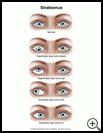
Eyes Turn Outward (Exotropia)
What is exotropia?
Exotropia is a type of strabismus. In exotropia, one or both eyes turn out toward the ear. It is sometimes called wall-eye.
In children, exotropia happens most often when the child is focusing on distant objects. It may happen only when the child is daydreaming, ill, or tired. It may get worse as the child gets older. In adults, it usually happens if vision is lost in one eye.
What is the cause?
The cause of exotropia is not known. Most experts believe that the brain has trouble controlling the position of the eye. This problem may run in families.
Sometimes when a child's eyes are not aligned on the same target, the brain ignores the image from one eye. That eye works less, and vision stops developing in that eye. This problem (called amblyopia or lazy eye) happens rarely with exotropia. It is more common with other forms of strabismus.
Exotropia may result from:
- nerve problems
- eye socket or eye deformities
- eye injuries
- head injuries
In adults, exotropia may be cause by the above problems, or by:
- thyroid disorders
- myasthenia gravis
- brainstem aneurysms or stroke
- circulation problems
- stroke and other blood vessel problems
- diabetes
- poor vision in one or both eyes
- multiple sclerosis
What are the symptoms?
One or both eyes appear to be turned out. They do not appear to be pointing in the same direction. Many children with exotropia shut one eye in outdoor light or squint one or both eyes.
How is it diagnosed?
An ophthalmologist (medical eye doctor) will test the person's overall vision and ability to follow objects with each eye.
How is it treated?
Children who only have exotropia sometimes may not need treatment as long as their eyes are able to work together. If the eye drifts often, it should be treated.
Treatment of more severe exotropia when it is first detected in young children may help the eyes work together. Treatment may include:
- patching the "good" eye
- eye exercises
- use of glasses with lenses that are too strong (called minus lenses)
If the eyes are always misaligned, surgery may be needed. During surgery, the doctor will tighten or loosen the eye muscles to change the alignment of the eyes. Sometimes the doctor will operate on muscles of both eyes even though only one eye is turned out.
Strabismus surgery is not cosmetic surgery. Having eyes that are not aligned normally interferes with the ability to communicate with others through eye contact.
How long will the effects last?
Children who have exotropia need to be treated as soon as possible by an eyecare provider so they can develop normal vision. Treatment that begins after the age of 6 years may improve a child's appearance but does not always help vision problems.
How can I take care of my child?
- Follow the treatment plan.
- Keep all appointments for provider visits or tests.
Last modified: 2011-10-10
Last reviewed: 2011-10-10

